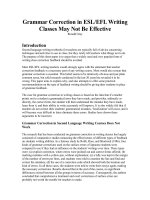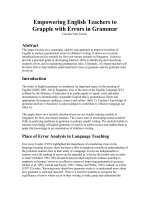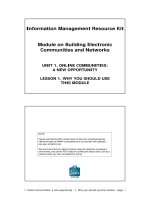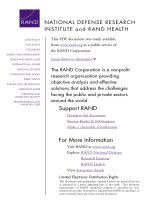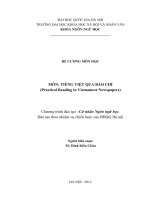Why Teachers Should Use Timed Reading in ESL Classes
Bạn đang xem bản rút gọn của tài liệu. Xem và tải ngay bản đầy đủ của tài liệu tại đây (93.6 KB, 5 trang )
Why Teachers Should Use Timed Reading
in ESL Classes
Jeremy Browning
Students are faced with a bombardment of information need to be better prepared for the
demands that reading in society places on them. This paper explores the importance of
gaining higher reading speed via timed reading and how strategic application is important
for its success. When teachers apply timed reading to their program, they better prepare
their students for the fast-paced world ahead of them.
Introduction
Reading is an all-important language skill that is now in more demand than in any time in
our history. With the exposure of the Internet in a global arena, students need to master
reading in order to understand the vast knowledge the world embraces them with. It has
been said that the literate adult today is reading more in one week than their great-
grandfather did in a whole year (Swalm and Kling, 1973). This fact places pressures on the
student to perform at a higher level than the student before them.
It is the belief of many teaching professionals that the ESL student needs to be able to read
at a level challengeable to a native speaker of English in order to keep up with the
academic workload. The idea of this paper is that through the training in timed reading, the
student will increase their reading speed, which will better prepared them for the challenges
they will encounter when they enter the collegiate playing field (Anderson 1999). There are
many reasons for implementing timed reading into a reading program and it is my wish to
elaborate on some of them in this paper.
The Benefits of Faster Reading
There are many benefits in gaining a faster reading rate and Klaeser (1977) presents four
positive points in this regard. The first one is the amount of time you will save when you're
able to double your speed (for example). With an increase in speed, the student will be able
to cover more materials than at a slower speed. Figure A illustrates the gains a student will
make when their speed is increased.
This illustration shows what the gains are for students that are slow readers (150 words per
minute (the average ESL student entering college)) versus students that are good readers
(350 words per minute). The difference in quantity is at about 2.33 times more for the faster
students. If the student increases their production to 250 WPM, they would be increasing
their reading production by 67%. These are important gains for the student that will
promote academic success.
The second advantage is that readers are able to concentrate better which leads to greater
comprehension. Of course this area is under debate because there have been studies of
students that lost comprehension when they were striving to increase their reading speed.
This is usually the cause of "rushed reading" and contains little more technique than
scanning. However, it is believed that through an "effective" timed reading program,
students can attain an increased reading rate and comprehension.
Thirdly, with the increase in potential speed and comprehension, academic grades tend to
rise as well. This is all due to the control of extra time, which allows for greater
understanding.
Timed
Reading
Rates
Slow Reader
(150 words per
minute)
Fair reader
(250 words per
minute)
Good Reader
(350 words per
minute)
1 Week 3/4 Book 1 1/4 Books 1 3/4 Books
1 Month 3 Books 5 Books 7 Books
1 Year 36 Books 60 Books 84 Books
10 Years 360 Books 600 Books 840 Books
Figure A
Lastly and most importantly, students will enjoy the act of reading more, which promotes
greater extensive reading, an added area for increased reading speed and comprehension.
With increased reading rate and motivation for extended reading, students will encounter
frequent and repeated vocabulary, which will transcend into other areas of language skills
development.
Reading Strategies
Like any reading program, increasing reading rate is more than just opening a book and
jumping into the text. Timed reading involves the use of various strategies in conjunction
with in-class exercises and extensive timed reading. Timed reading isn't reading as-fast-as-
you-can over a passage and simply marking the gradual improvement (if there are any). It
involves reading strategies via the teacher's instruction.
Successful readers reported that they used various strategies such as reading in broad
phrases, skipping inessential words, guessing from context, and continuing to read the text
even when they encountered a term that they didn't know (Wallace 2001). Training in
strategic use is what timed reading promotes and reflects what Devine means by,
"...training enhances the metacognitive knowledge base of readers and results in improved
reading performance."(Devine 1993)
Another strategy mentioned by Wallace is the ability to make informed predictions as the
student progresses through the text (Goodman 1967, Smith 1971, Wallace 2001). Through
making predictions, students take an interactive role in the reading process, which Blanton
states is "...at the heart of literacy, formal learning, and academic success" (Blanton 1994).
This interaction is stimulated by the reader's background knowledge that acts as a catalyst
for text comprehension. Afflerbach researched the effects of background knowledge on
readers and found that those readers who applied background knowledge or had extensive
applicable prior knowledge were able to construct the main idea faster than those who
didn't (Afflerbach 1990, Zhicheng 1992).
Kitao utilizes pre-reading activities to unleash knowledge the students might have about the
passage, such as having them read the title, headings, and first lines of the paragraph for
initial gist (Kitao 1994). Kitao also employs other strategies like scanning (for specific
information), skimming (for gist), understanding the pieces of information by mentally
tying them together as the student proceeds throughout the text, understanding the
sequence of events/ideas in the reading, and lastly, visualizing the descriptions as the
students zip through the text at a rate above rauding.
Lono utilizes different strategies to attain quick information on the thesis of what is being
read by reading the first and last sentence of each paragraph, reading the introduction and
conclusion, and reading transition words that may show a change in the authors thought
and direction (Lono 1987).Pre-reading strategies allow students to attain an advanced idea
of what the text is about, which helps increase their speed and comprehension during the
timed reading process.
Phrase Reading
There is a structural technique that timed-reading instructors employ to aid in the speed of
reading. This is known as Phrase Reading. This was developed because of how the eyes
move across the page. When an individual reads they move across the text fixating on
certain words. When a jerk in motion occurs between fixations, a saccadic motion occurs.
This particular motion doesn't pick up information for the brain to process (Klaeser 1977).
Klaeser states that
"a good reader does between 85-95% of his reading time fixating...5-15% percent moving
from fixation to fixation. A poor reader spends more time moving and less time fixating.
Why? Because a good reader makes each fixation work better for him. By seeing two or
three words at each fixation, his saccadic movements are rapid jerks from phrase to
phrase... the poor reader fixates on every single word, sometimes on every syllable or every
letter. To become a good reader, the goal for using the eyes well is obvious: try to read two
or three words at a glance"
(Klaeser 1977).
Plaister supports this idea by implementing it in his ESL program. He administers timed
reading exercises and reading strategies to aid in the students speed and comprehension. He
explains that, "Most of our students are word-by-word readers and, as a consequence, read
at very low rates -- 125 to perhaps 150 words per minute (the average native speaker is at
around 300 WPM). Evidence shows that reading by structures help native speakers gain
comprehension" (Plaister 1968)
It is clear that strategies play an intricate role in the effective development of any reading
program. This is especially true for timed-reading because emphasis tends to reside in the
speed of reading and comprehension. The interaction with the text in timed reading forces
the ESL learner to move beyond the word level of reading (bottom-up), that most tend to
be in, to a level that requires cognitive negotiations of meaning (top-down).
Automaticity
One of the reasons proposed by many theorists for readers being able to read faster is
through the reflex of automatic responses to vocabulary and text comprehension across the
written work. This "unconscious" response is termed Automaticity and refers to the internal
understanding of what is being read and the complete comprehension of appropriate
vocabulary. By appropriate, I'm referring to reading materials that apply to a specific task
in relation to the students abilities. A reading task that is cognitively undemanding and
content embedded (Cummins and Swain 1986) will produce a more automatic process.
Materials that are more demanding, like academic work for example, will demand less
automatic movement because the reading is denser and the vocabulary is more reserved for
a specific context.
Automaticity is a nice residual skill that is brought about by combining many learning
elements, but I question its idealized effect. Anderson's exemplary analogy of himself
driving home emphasizes the automatic nature of getting home without thought, but he also
mentions that he didn't remember the details of the trip (Anderson 1999). This makes me
question Automaticity's function on comprehension. I feel the automatic motion is
established from a habitual action in conjunction with tangent thinking. The tangent
thinking produces a loss of thought. Am I making this sound ineffective? Actually, I feel
that there are two kinds of Automaticity, (a.) Unconscious Automaticity and (b.) Conscious
Automaticity.
Unconscious Automaticity
This occurs as in the above examples where the individual undergoes actions through an
automatic function, which was caused by the mind going off course. Like the times when I
took a shower and couldn't remember if I washed my hair. I ended up double washing
because of a tangency in thought. This doesn't help the student, but instead causes them to
backtrack and read the material again (time loss).
Conscious Automaticity
This is established when the habitual motion is consciously acknowledged and the process
is unconsciously executed. An example of this is when I was on the wrestling team in high
school. During a match, I remember executing a wrestling technique to counter my
opponent's assault. I remember going through some motions, which were triggered by my
opponent's hand positioning on my body. The series of moves took only about a second
and resulted in a win for me. I was aware of what I was to do (split second) and I
automatically executed it. This is what the ESL reader needs to do. Carver's description of
Automaticity coincides with this explanation and timed reading as follows:
"Automaticity theory has forced a focus upon the role of repetition as a primary factor that
causes improvement in reading rate. Practice in decoding known words supposedly should
result in there being read more rapidly and with little attention because they will be
perceived more rapidly while attention is being directed toward understanding the complete
thought represented by all the words in the sentence"(Carver 1990).
As the student practices timed reading and is exposed to various language learning
elements, as mentioned above, they become more automatic in their response due to the
holistic experience. Timed reading forces the re-occurrence of certain, frequent vocabulary
to be internalized, which ultimately aids in the speed and comprehension of reading
materials.
Conclusion
Timed reading is more than just reading as fast as you can and hoping your speed will
increase with practice. It's a process of implementing various elements from reading theory
to make it work more efficiently and effectively. Taking into consideration the students
needs, background, and affective domains help shape the content of timed reading.
Promoting the use of strategies adds to the ease of reading rate increase in the long term as
well as an increase in reading for pleasure. ESL students will benefit from the use of these
timed reading components, but only as long as they have realistic goals, patience and
practice in timed reading skills. The practice will create an automatic response towards the
text reading, which will prepare the student for the task of greater reading demands that
society has placed on them.
